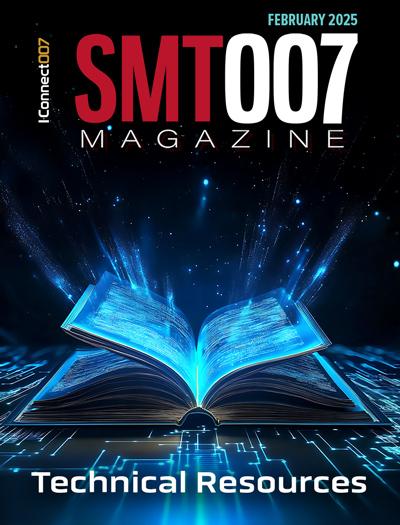-

-
News
News Highlights
- Books
Featured Books
- smt007 Magazine
Latest Issues
Current Issue
Do You Have X-ray Vision?
Has X-ray’s time finally come in electronics manufacturing? Join us in this issue of SMT007 Magazine, where we answer this question and others to bring more efficiency to your bottom line.

IPC APEX EXPO 2025: A Preview
It’s that time again. If you’re going to Anaheim for IPC APEX EXPO 2025, we’ll see you there. In the meantime, consider this issue of SMT007 Magazine to be your golden ticket to planning the show.

Technical Resources
Key industry organizations–all with knowledge sharing as a part of their mission–share their technical repositories in this issue of SMT007 Magazine. Where can you find information critical to your work? Odds are, right here.
- Articles
- Columns
Search Console
- Links
- Media kit
||| MENU - smt007 Magazine
Rehm Launches Flexible 2-in-1 Solution for Reflow Soldering
July 27, 2015 | Paul Wild, Rehm Thermal Systems GmbHEstimated reading time: 2 minutes
The desire for higher throughput and better integration of SMD lines require new technological solutions. In line with this, Rehm Thermal Systems has introduced a vacuum unit that enables convection soldering processes with or without vacuum – with only one soldering system.
Energy-efficient, low-maintenance and voidless, the new solution features two technologies—the convection reflow soldering system VisionXP+ and a vacuum chamber—that had been united to provide this new option.
As soon as the solder is molten—and while the solder is still in the optimum molten state—the VisionXP+ with vacuum option reliably removes voids and gas emissions. Void content of less than 2% can be realised with a vacuum between 100 mbar and 10 mbar (Figure 1a). For an exact setting of the process parameters the vacuum level is measured directly in the process chamber. Pressure gradient and the speed of the vacuum process can be set individually and profile parameters can be saved. The mechanical system construction allows to optionally use the vacuum or to apply it as a classic convection soldering system (Figure 1b).
Figure 1: X-ray images of a QFN44 solder joint following soldering process (a) with vacuum and (b) without vacuum with the VisionXP+ Vac system.
The vacuum chamber is installed (Figure 2) as an enhancement to the available peak zones. The integrated pyrolysis and separate filtering of the atmosphere extracted from the vacuum chamber makes maintenance and cleaning easy. The vertical travel range and automatic service positions of the vacuum chamber allowing good access to the internal mechanisms during maintenance periods and minimises downtimes and reduces maintenance effort.
Figure 2: A convection soldering system of type VisionXP+ Vac with vacuum chamber.
The system has a higher throughput by a second transport track and comes with a tripartite transport system: pre-heating/peak area, vacuum unit and cooling zone, and optional with a central support for particularly wide boards. Transportation speed in the cooling zone can be reduced, and cooling time of components can be extended to assure optimum temperature for the subsequent process steps.
All heating zones are regulated individually and thermally separated from each other to assure a stable reflow process, flexible pressure and temperature profile guidance. Figure 3 shows a temperature profile with the vacuum process switched on. With a very low vacuum of 10 mbar profile settings ≤3K/s heating, tL≤90s, TP≤240°C had been fulfilled. With the integrated heating in the chamber, the component temperature can be adapted to the most common standards.
Figure 3: Pressure and temperature profile of a soldering process with the VisionXP+ Vac.
In order to identify a suitable combination of condensation or convection soldering and vacuum technology, the individual aims should be analysed. Table 1 compares several important features of the two vacuum soldering procedures.
Table 1: Comparison convection and condensation soldering systems with vacuum.
Suggested Items
INEMI Call-for-Participation Webinar: BiSn-Based Low-Temperature Soldering Process and Reliability Project Phase 3b
04/28/2025 | iNEMIIn 2015, INEMI initiated the BiSn-Based Low-Temperature Soldering Process and Reliability Project to assess the feasibility of using low-temperature solders (LTS) in the SnBi system to address various technological, economic and ecological drivers for assembly of consumer computer electronic board products.
KYZEN to Feature Stencil Cleaning and Aqueous Cleaners at SMTA Capital Expo and Tech Form
04/28/2025 | KYZEN'KYZEN, the global leader in innovative environmentally responsible cleaning chemistries, will exhibit at the SMTA Capital Expo and Tech Forum, scheduled to take place Thursday, May 8 at George Mason University – Mason Square in Arlington, VA.
KYZEN Focuses on Aqueous Cleaning and Stencil Cleaning at SMTA Wisconsin
04/24/2025 | KYZEN'KYZEN, the global leader in innovative environmentally responsible cleaning chemistries, will exhibit at the SMTA Wisconsin Expo and Tech Forum, scheduled to take place Tuesday, May 6 at the Crowne Plaza Milwaukee Airport. KYZEN will be on-site to provide attendees with information about aqueous cleaning chemistry AQUANOX A4618 and stencil cleaner KYZEN E5631J.
SMTA Bridging the Skills Gap in Arizona
04/24/2025 | Marcy LaRont, I-Connect007One area where SMTA really excels is through its local chapters. On April 16, 2025, I-Connect007's Marcy LaRont attended the Workforce Breakfast during the SMTA Arizona Expo & Tech Forum in Mesa, which featured more than 50 electronics professionals from the local area, including defense OEMs, and others who were attending for the first time. Blackfox and Hyrel Technologies sponsored the event. The keynote presentation featured Sean Denny, a professor at Estrella Mountain Community College, who emphasized a clear need for skilled hand soldering technicians.
IPC Releases Version 2.0 of IPC-2591, Connected Factory Exchange, with Expanded Device Coverage and Smarter Data
04/23/2025 | IPCIPC announces the release of IPC-2591, Connected Factory Exchange (CFX), Version 2.0, the global standard for plug-and-play, machine-to-machine, and machine-to-system communication for digital manufacturing.


